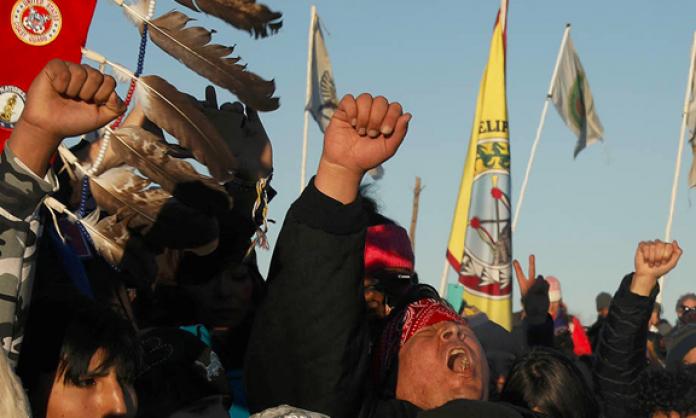Native Americans and their allies won an important battle in their fight to prevent the Dakota Access Pipeline going through historic tribal lands of the Sioux, and under part of the Missouri River where the Sanding Rock Sioux reservation gets its drinking water.
The battle was joined by the US Army Corps of Engineers (ACE), which issued an ultimatum that the protest site be disbanded by 4 December or the participants would face arrest and prosecution. That would have meant a repeat of brutal police attacks against the non-violent protest – with clubs, attack dogs, tear gas, rubber bullets, fire hoses in temperatures lower than minus 12 degrees Celsius, stun grenades, and mass arrests. (One of these grenades previously shredded the flesh of the arm of a young woman, who is undergoing multiple surgeries.)
The Standing Rock struggle had already won wide support, but this ultimatum spurred a qualitative new surge of solidarity, with many new supporters coming to North Dakota to put their bodies on the line. By 3 December, 10,000 had joined the struggle at Standing Rock. In addition, there were protests in many cities against the big multinational banks financing the pipeline.
A key aspect of this new surge was veterans of the US armed forces, many Native American but others too. They were prepared to form a line of defence between the cops and the protest site. The cops would have to go through them first. By 3 December, there were 2,000 veterans ready for the battle. As an article in the New York Times reported on 5 December described:
“Some were old men, veterans of Korea and postwar Europe, who said they had grown up in Indian boarding schools where they were beaten for speaking their language. Some drove in from reservations across the Plaines.
“Some of the arriving veterans have spent years in the antiwar movement after returning from Vietnam or Iraq. They said they saw the pipeline protests as a new chapter in their activism …
“‘A lot of people here are willing to sacrifice their body, willing to give their life’, said Vincent Emanuele, 32, a former Marine who served in Iraq and has spoken out extensively against what he called a futile war. ‘You might as well die for something that means something.’
“Others said they did not care much about politics and had never joined a protest. But they said they had been moved by the tribe’s fight … Or they said they were angry at seeing images of violent clashes between lines of law enforcement and Native Americans.
“‘I just couldn’t believe what was happening in the United States’, [a veteran] said. ‘Even in Iraq, there was some rule of engagement. If these guys don’t have weapons, it just doesn’t make sense to me that it’s a shooting gallery’.”
The threat of the spectacle of militarised police charging unarmed veterans gave the powers that be cause for concern, and there were a series of retreats, with the ACE backing down from the threats of force.
Then on 4 December, the ACE (obviously under White House orders) denied Energy Transfer Partners, the company doing the construction, the permit to start building the pipeline underneath the river, officially halting construction.
On hearing the news, the encampment broke out into cheers and celebrations, echoed by supporters throughout the country.
But the mood was more sober the next day. Energy Transfer Partners reacted to the AEC decision by saying it meant nothing. It implied that the under river construction would proceed anyway – although that is uncertain, as it would lead to a direct clash with the federal government.
More certain is ETP’s boast that it has the full backing of Donald Trump, who has loudly proclaimed that he will OK the Dakota Access Pipeline, reverse the Obama administration decision to block the XL pipeline, and scrap regulations on the energy industry.
Trump, as Commander in Chief of the armed forces, could order the ACE, part of the army, to use force.
So the water protectors know they may have to re-mobilise.
The power of mass mobilisation won this battle. First of all, the Standing Rock Sioux united to act. Then other tribes joined in, including from Canada. Eventually, more than 200 tribes supported the struggle at Standing Rock, overcoming differences in a show of solidarity. This was the largest gathering of Native Americans in struggle since the American Indian Movement of the last radicalisation in the US in the 1960s-70s.
That they stood up and fought back encouraged others to come in support. Environmental groups recognised this fight against Big Oil was their fight too. Black Lives Matter activists saw a kindred struggle, as did many other groups and individuals.
Nothing inspires oppressed and exploited people like a mass battle being waged against the ruling class. That this one was successful – even if conditional – furthers a sense that mass action is effective. In the protest camp, a renewed sense of their power was expressed. If there is need for further mobilisation, this confidence will give them strength.
This spirit will spill over into other struggles, too.










